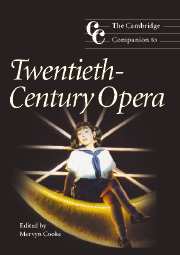Book contents
- Frontmatter
- Part one Legacies
- Part two Trends
- Part three Topographies
- Part four Directions
- 14 Music theatre since the 1960s
- 15 Minimalist opera
- 16 Opera and film
- 17 Popular musical theatre (and film)
- 18 Opera in the marketplace
- 19 Technology and interpretation: aspects of ‘modernism’
- Works cited
- General index
- Index of operas
17 - Popular musical theatre (and film)
from Part four - Directions
Published online by Cambridge University Press: 28 September 2011
- Frontmatter
- Part one Legacies
- Part two Trends
- Part three Topographies
- Part four Directions
- 14 Music theatre since the 1960s
- 15 Minimalist opera
- 16 Opera and film
- 17 Popular musical theatre (and film)
- 18 Opera in the marketplace
- 19 Technology and interpretation: aspects of ‘modernism’
- Works cited
- General index
- Index of operas
Summary
Spaces and genres
From Buxton to Ballarat, Manchester to Manaus, the London Coliseum to Central City, Colorado, the world is full of imposing opera houses built one hundred or more years ago that cause one to wonder just how much opera has gone on inside them. As architectural spaces, they have one and all catered for a mass public's aspirations towards plush velvet seating, regal insignia, the boudoir gilt, livery and privileged partial view (both in and out) found alike in private box and private coach, and the magical illusion of the proscenium stage. Theatrical magic is essentially that of a show, of the dazzle of a star, the virtuosity of a spectacle or the tension of a tragic or comic surprise; music adds magic of its own with the wondrous sounds proceeding from the star's mouth and, unseen or at least unobserved, from the orchestra pit. Some of the musical sounds and shows inhabiting such theatres have constituted opera proper; many of them have not. The dressing rooms, stages and musical cues have been prepared similarly for performing dogs and divas; from the tired businessman in the stalls to the gold prospector or Japanese tourist in the gallery, the men in the audience have ogled Melba, Mary Martin or a potential mistress, the women their men, their matinée idol or their neighbour's jewellery.
- Type
- Chapter
- Information
- The Cambridge Companion to Twentieth-Century Opera , pp. 291 - 305Publisher: Cambridge University PressPrint publication year: 2005
- 1
- Cited by



